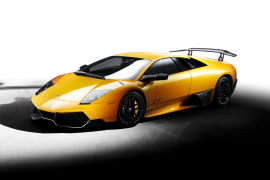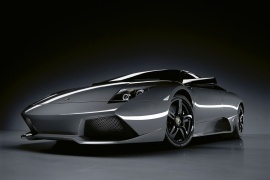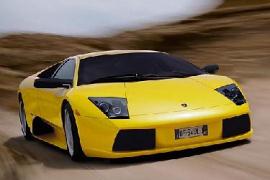LAMBORGHINI Murcielago Models/Series Timeline, Specifications & Photos
First production year: 2001
Engines: Gasoline
Body style: Coupé (two-door)
In 2009 Lamborghini launched the most powerful vehicle from its lineup to that date, the Murcielago LP670-4 SV, but the world financial crisis partly killed it.
The Italian automaker planned to build 300 units of the LP 670-4 SuperVeloce, but the world economy was collapsing, and the car industry took a beating. Obviously, Lamborghini also suffered, but in a different way than others. It survived but was crippled. It produced just 186 units before retiring the Murcielago from the assembly lines to make room for its successor, the Aventador.
Like many other SV versions built before it for several other models, such as the Miura SV and the Diablo SV, the Murcielago SV shared many of its parts with the regular version. Yet, the automaker replaced some of them to shave about 100 kg (220 lbs) from the original vehicle. The black carbon fiber spoiler from the front, plus the wing and diffuser in the back, were specific for this version. Moreover, a set of side scoops placed behind the scissor-type doors further emphasized the supercar's aggressive look.
Inside, the automaker carefully placed the SV logo inside the tachometer so the driver never forgets what they're driving. The Alcantara-wrapped dashboard canceled all reflections to help the one behind the wheel stay focused on the road. Additional carbon fiber trims were installed on the center console, door cards, dashboard, and steering wheel.
Mounted behind the cockpit, in a longitudinal position (hence the LP designation), the 670 PS (661 hp) engine was a work of art by itself. The dry sump lubrication system and the high-performance processors for each cylinder bank made the massive V12 spin with up to 8,000 rpm. Its 660 Nm (487 lb-ft) of torque was sent to the rear wheels via an automated, single-clutch, six-speed gearbox. As a no-cost option, the automaker offered the supercar with a manual transmission. Both versions sent the power in all corners, hence the -4 in the model's designation. With the standard wing on the back, the car could reach up to 337 kph (209 mph), which provided more downforce and higher drag resistance. An optional smaller one allowed the vehicle to increase that value to 347 kph (213 mph).
LAMBORGHINI Murcielago LP 670-4 SuperVeloce 6.5 V12 6MT (670 HP)
Lamborghini launched the Murcielago in 2001 and, in 2006, its originally 580 hp engine didn't look that much anymore, facing stiff competition from other brands. So, it came with the LP640 and some subtle aesthetic improvements.
Lamborghini was bought by the Volkswagen Group in 1998 from a Malaysian investment group. Its turbulent history with ups and downs was calmed down under German ownership and it was placed under Audi control. That is why it had some Audi parts in some of its models. But the Murcielago didn't have that many connections with any of the German cars.
On the outside, there was a new chin under the short front overhang, and in the rear, there was an option for a glass-covered engine lid, so the owner could brag with the V12 underneath. The car was big and powerful and its status as one of the greatest supercars ever made was rocked by other car manufacturers, including Porsche and, of course, the traditional opposition from Ferrari. In the rear, on the lower side, there was a tailpipe with huge dimensions. It could be easily mistaken with the drainage for a street.
The luxurious interior featured leather seats, a leather-covered dashboard and center console, and aluminum pedals. The gearshift lever was straight-up from the center console.
But Lamborghini didn't make the LP640 just by adding some horses, a chin, and an exhaust. It also tweaked the suspension and improved the brakes. As an option, carbo-ceramic brakes were offered.
When Lamborghini introduced the Murcielago in 2001, it was already owned by Volkswagen Group, and it had enough money to create a unique supercar.
The carmaker already knew that it had to adapt to new customers and that the hard-core enthusiasts would have to deal with the all-wheel-drive systems and the new design. Moreover, Volkswagen brought Luc Donkerwolke onboard, and he penned the car with angular shapes but managed to create an aerodynamic shape.
With a 4 ft (1.2 meters) height and an unusually wide stance, the Murcielago was the shocking-looking vehicle that Lamborghini needed. The car's angular-shaped headlights and the big air intakes in the apron made it look like a hungry beast ready to eat everyone and everything in its path. The designer didn't forget that such a supercar needs impressive cooling areas, so he developed adjustable side air-scoops to cool the engines. As a brand-specific signature, the scissors doors were kept.
Despite its wide stance, the Murcielago was actually pretty cramped inside. There was a tall center console between the sport bucket seats and a center stack that supported the sound system and the HVAC controls. On top of it, there were a pair of round vents that clearly didn't match the car's angular shapes. But they worked fine, and customers didn't complain. Inside the instrument cluster, Lamborghini placed two big dials for the speedometer and tachometer while the rest of the gauges and warning lights flanked them.
Like its predecessor, the Diablo, this 2001 Lamborghini featured a V12 engine placed behind the cabin. It was a 6.2-liter unit mated either with a six-speed manual or a six-speed automatic. Power went in all corners via a viscous center differential.


